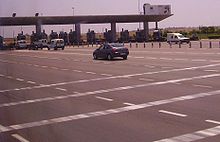- Autoroutes of Morocco
-
Morocco's network of expressways is administered by the state-owned company Autoroutes du Maroc (ADM). It runs the network on a pay-per-use basis, with toll stations placed along its length. The general speed-limit is 120 km/h.
Contents
History
The first expressway in the country is the A3: Casablanca-Rabat. Construction of the first section started in 1975 but completion of this road between the economic and the administrative capital took 13 years. Originally usage of the road was free of charge. The toll-road system was later introduced as one measure to prevent lengthy construction times (as happened with this first road). Finding investors for new roads would be easier when these roads would generate their own revenue to repay investors.[1]
Realized and planned
As of July 2011, ADM manages 1420 km of Morocco's toll roads [2]. In 2006, it was announced that ADM will be investing 6.18 billion dirhams ($859 million) to develop its highway network in 2007.[3]. These investment packages are part of the objective which aim to complete 1,500 km by 2012.
Completed roads
The main Moroccan expressways are:
- A1 Rabat-Tanger (223 km)
- A2 Rabat-Fes (207 km)
- A3 Casablanca-Rabat (65 km)
- A4 Tangier-TangerMed port (54 km)
- A5 Casablanca ring (34 km)
- A6 Tetouan-Fnideq (28 km)
- A7 Casablanca-Agadir via Marrakesh (453 km )
- A5 Casablanca-El Jadida (80 km)
- A9 Fes-Oujda length: 320 km avg.costs/km: 28 MDH[4]
The separately developed stretches, used to create the main N-S and E-W links are:[5][6]
Moroccan Expressways from to length
in km.construction
periodavg costs
MDH/kmnotes Casablanca Rabat 62 forming the A3 motorway using: Casablanca Oued Cherrat 33,5 1975–1978 and: Oued Cherrat Rabat 25,5 1983–1987 Rabat Larache 150 13 using: Rabat Kénitra 40 1993–1995 and: Kénitra Larache 110 1993–1996 Larache Sidi El yamani 28 1996–1999 Sidi El yamani Asilah 15 2000–2002 Asilah Tanger 30 2002–2005 together forming the A1 Rabat-Tangier expressway Rabat Fès 167 14,4 using Rabat Khemiset 66 1996–1999 and Fes Khemiset 116 1995–1998 Casablanca Settat 57 1998–2001 17,5 Casablanca bypass 27 2000–2004 25 built in 2 phases Casablanca El Jadida 85,5 using Casablanca Had Soualem 16 2001–2004 18 and Had Soualem Tnine Chtouka 35 2002–2005 20 and Tnine Chtouka El Jadida 28 2004–2006 26 Settat Marrakech 162 2004–2007 Desserte du Port Tanger Med 54 2004–2008 73 Tétouan Fnideq 28 2004–2008 36 last 11 km opened 21-07-08 Under construction
In 2008 the following roads were under construction:[6][7]
Future plans
ADM has far developed plans to start in 2009 with:[7]
- upgrading the A3 Casablanca-Rabat
- by widening the road from 2 x 2 to 2 x 3 lanes over 58 km. Planned completion in 2012
Road safety
In 2007 762 accidents with casualties were reported, a 5% increase on 2006. The accident-rate per 100 million traveled kiloneters dropped by 20% from 30,2 to 24,1 between these years, but the total number as well as rate of deaths didn't go down.
A break-down of these figures:[8]
Moroccan Expressways Safety Type accident 2006 2007 % change notes serious accidents 726 762 +5% is accident with serious inj. or deaths rate per 100 mln km. 30,2 24.1 -20% fatal accidents 74 86 +16% is accident with at least one death rate per 100 mln km. 3,1 2,7 -12% serious injuries 480 535 +11% is per 100 mln km. 20,0 16,9 -15% deaths 90 127 +41% is per 100 mln km. 3,7 4,0 +7% Increasing road-safety
Increasing safety is an important goal for the ADM: the new autoroutes are designed to improve safety and the ADM also believes that extending the express-way network will increase overall safety as the through-going (and often high-speed) traffic is moved away from the Route Nationals, that run through the cities and villages along the way. Expressways also use non-level crossings and because there is no oncoming traffic overtaking cars is safer then on normal roads. The ADM also publishes accident figures to increase the attention of the public in road-safety.[9].
In the first quarter of 2011 the number of accidents on expressways with injuries fell 21% compared to the same period in 2010[10]
See also
References and notes
- ^ Website of ADM about its history, visited 4 August 2008.
- ^ Overview main development figures on ADM site, visited september 2010.
- ^ "Morocco strengthens infrastructural development". http://business.andnetwork.com/index?service=direct/1/Home/recent.titleStory&sp=l52701. Retrieved September 28, 2006.
- ^ http://www.lematin.ma/Actualite/Journal/Article.asp?idr=110&id=154002
- ^ Data obtained from key dates
- ^ a b development program on ADM site as on 4 August 2008
- ^ a b Detailed project figures on ADM site, visited 3 August 2008
- ^ Official safety figures as reported by ADM, visited 3 August 2008
- ^ ADM Website Detailed report on road-safety on expressways, PDF (French), retrieved 27 June, 2011
- ^ Newsarticle on ADM website 21% decrease in traffic accidents on motorways in Q1 2011, visted 27 June, 2011
Highways in Morocco Autoroutes A1 expressway · A2 expressway · A3 expressway · A5 expressway · A6 expressway · A7 expressway · A11 Berrechid- Beni Mellal expresswayNational routes  Economy of Morocco
Economy of MoroccoIndustries and sectors Overview Agriculture • Finance • Fishing • TourismEnergy Energy policy • Desertec • Renewable energy • Wind powerTechnology Information technology • Science and technology • TelecommunicationsTrade and Investment Casablanca Stock Exchange • Companies • Investment • MADEX • TradeTransportation Airlines • Autoroutes • Rail transport • ONCF • Tanger-Med port • TransportationRelated topics Regional economies Casablanca • Tangier • Western SaharaFree Trade Agreements Agadir Agreement • Euro-Med FTA • GAFTA • US-Morocco FTAGovernment policies Bank Al-Maghrib • Plan Azur • Plan Emergence • PrivatizationHistory Economic history • Falus • Trade historyCurrency: Moroccan DirhamCategories:- Autoroutes in Morocco
- Toll roads
Wikimedia Foundation. 2010.

